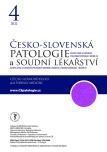The changes and updates in the fifth edition of the WHO Classification of prostate tumors
Authors:
Ondrej Ondič 1,2
Authors‘ workplace:
Šiklův ústav patologie, Univerzita Karlova Praha, Lékařská fakulta Plzeň, Česká Republika
1; Bioptická laboratoř, s. r. o., Plzeň, Česká republika
2
Published in:
Čes.-slov. Patol., 58, 2022, No. 4, p. 205-206
Category:
Reviews Article
Overview
The fifth edition of the WHO classification of prostate tumors provides new insight into prostate cancer pathogenesis supported by molecular data. It discards the terms low-grade PIN and high-grade PIN. The new entity „Treatment-related neuroendocrine prostatic carcinoma“ is introduced. The importance of the diagnosis of intraductal carcinoma is highlighted. The terminology of prostatic basocellular carcinoma is upgraded. Some cancer subtypes are being relocated to different chapters based on new findings. Also, the role of the prostate as an origin of hereditary cancer is stressed. Finally, the new therapeutic approaches are mentioned.
Keywords:
prostate – cancer – WHO classification 2022
Sources
1. WHO Classification of Tumours Editorial Board. Urinary and male genital tumours (5th ed). Lyon: International Agency for Research on Cancer; 2022.
2. Epstein JI, Amin MB, Beltran H, et al. Proposed morphologic classification of prostate cancer with neuroendocrine differentiation. Am J Surg Pathol 2014; 38(6): 756-767.
3. Akamatsu S, Inoue T, Ogawa O, Gleave ME. Clinical and molecular features of treatment- related neuroendocrine prostate cancer. Int J Urol 2018; 25(4): 345-351.
4. Kaur HB, Salles DC, Paulk A, Epstein JI, Eshleman JR, Lotan TL. PIN-like ductal carcinoma of the prostate has frequent activating RAS/RAF mutations. Histopathology 2021; 78(2): 327-333.
5. Epstein JI, Amin MB, Fine SW, et al. The 2019 Genitourinary Pathology Society (GUPS) white paper on contemporary grading of prostate cancer. Arch Pathol Lab Med 2021; 145(4): 461-493.
6. Iczkowski KA, Ferguson KL, Grier DD, et al. Adenoid cystic/basal cell carcinoma of the prostate: clinicopathologic findings in 19 cases. Am J Surg Pathol 2003; 27(12): 1523-1529.
7. Begnami MD, Quezado M, Pinto P, Linehan WM, Merino M. Adenoid cystic/basal cell carcinoma of the prostate: review and update. Arch Pathol Lab Med 2007; 131(4): 637-640.
8. Abida W, Cheng ML, Armenia J, et al. Analysis of the prevalence of microsatellite instability in prostate cancer and response to immune checkpoint blockade. JAMA Oncol. 2019; 5(4): 471-478.
9. Latham A, Srinivasan P, Kemel Y, et al. Microsatellite instability is associated with the presence of Lynch syndrome pan-cancer. J Clin Oncol 2019; 37(4): 286-295.
10. Castro E, Goh C, Olmos D, et al. Germline BRCA mutations are associated with higher risk of nodal involvement, distant metastasis, and poor survival outcomes in prostate cancer. J Clin Oncol 2013; 31(14): 1748-1757.
11. Flippot R, Patrikidou A, Aldea M, et al. PARP inhibition, a new therapeutic avenue in patients with prostate cancer. Drugs 2022; 82(7): 719-733.
12. McNeal JE, Yemoto CE. Spread of adenocarcinoma within prostatic ducts and acini. Morphologic and clinical correlations. Am J Surg Pathol 1996; 20(7): 802-814.
13. Guo CC, Epstein JI. Intraductal carcinoma of the prostate on needle biopsy: Histologic features and clinical significance. Mod Pathol 2006; 19(12): 1528-1535.
14. Epstein JI, Egevad L, Amin MB, Delahunt B, Srigley JR, Humphrey PA; Grading Committee. The 2014 International Society of Urological Pathology (ISUP) consensus conference on Gleason grading of prostatic carcinoma: definition of grading patterns and proposal for a new grading system. Am J Surg Pathol 2016; 40(2): 244-252.
15. Chua MLK, Lo W, Pintilie M, et al. A prostate cancer „nimbosus“: Genomic instability and SChLAP1 dysregulation underpin aggression of intraductal and cribriform subpathologies. Eur Urol 2017; 72(5): 665-674.
16. Böttcher R, Kweldam CF, Livingstone J, et al. Cribriform and intraductal prostate cancer are associated with increased genomic instability and distinct genomic alterations. BMC Cancer 2018; 18(1): 8.
Labels
Anatomical pathology Forensic medical examiner ToxicologyArticle was published in
Czecho-Slovak Pathology

2022 Issue 4
Most read in this issue
- New insights in the new WHO classification of adult renal tumors
- Key changes in WHO classification 2022 of testicular tumors
- Tumor lesions of penis and scrotum according to WHO classification 2022
- The changes and updates in the fifth edition of the WHO Classification of prostate tumors
